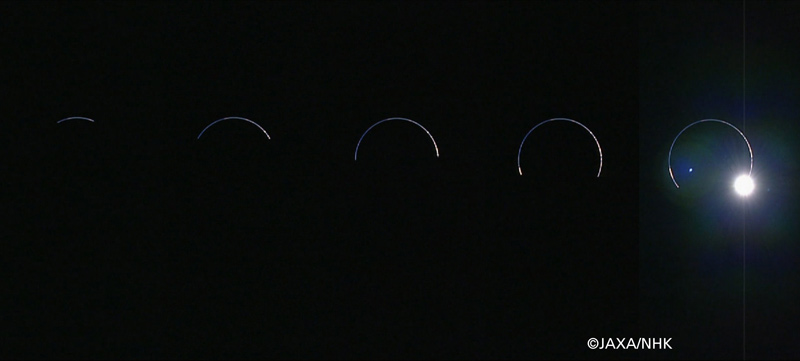Eclipse Seen by Moon Probe as Earth Blocks Sun

Japan?s Kaguya lunar orbiter hasbeamed home a spectacular movie of Earth eclipsing the sun as seen from themoon.
Kaguya caughtthe stunning sight on Feb. 10 and used its high definition camera to recordthe moment when the Earth looked like a diamond ring.
This HDTV moment in time and space came when a penumbrallunar eclipse occurred and the view of the sun from the Kaguyawas mostly covered by the Earth, thus the Earthlooked like a diamond ring. The moon?s limb, hidden by darkness, obscures part of the lowerportion of the ring.
According to Japan Aerospace Exploration Agency (JAXA)officials, this is the first time that this phenomenon was shot from the moon. JAXAoperates Kaguya, which launched toward the moonin September 2007.
Eclipses occur when the sun, Earth and moon are lined upperfectly. At full moon, there can be a lunar eclipse, as seen from Earth.At new moon, there can be a solar eclipse. Because the moon orbits Earth in aplane slightly offset compared to the plane of Earth?s orbit around the sun,eclipses don?t occur every month, however. And when we?re having a lunareclipse, anyone on the moon, at least if they?re in the right spot, could seethe sun blocked by Earth.
Kaguya project manager Susumu Sasaki hasnoted that the orbiter will continueits observations until early 2009 using the main orbiter on the same orbitof 62 miles (100 km) in altitude above the Moon. Kaguyacarried a pair of smaller microsatellites to the moonwhen it launched. Those smaller craft were deployed shortly after it enteredlunar orbit.
The spacecraft will then lower its altitude sometime inspring to perform higher accuracy and new additionalobservations on the Moon's magnetic fields, plasma environment, and make othermeasurements. The plan is to drop the main orbiter on the near side of theMoon before the summer of 2009.
Get the Space.com Newsletter
Breaking space news, the latest updates on rocket launches, skywatching events and more!
- New Video - Earth?s Diamond Ring Shines in Kaguya Eclipse
- Video - Kaguya Captures Full Earth-rise
- Top 10 Cool Moon Facts
Join our Space Forums to keep talking space on the latest missions, night sky and more! And if you have a news tip, correction or comment, let us know at: community@space.com.

Leonard David is an award-winning space journalist who has been reporting on space activities for more than 50 years. Currently writing as Space.com's Space Insider Columnist among his other projects, Leonard has authored numerous books on space exploration, Mars missions and more, with his latest being "Moon Rush: The New Space Race" published in 2019 by National Geographic. He also wrote "Mars: Our Future on the Red Planet" released in 2016 by National Geographic. Leonard has served as a correspondent for SpaceNews, Scientific American and Aerospace America for the AIAA. He has received many awards, including the first Ordway Award for Sustained Excellence in Spaceflight History in 2015 at the AAS Wernher von Braun Memorial Symposium. You can find out Leonard's latest project at his website and on Twitter.









